What
is warm in winter is hot jazz, and for its 15th edition Jazz
En Rafale provided the heat and timely “Take
Five” from the cold.
Unlike
last year, which featured the piano, and 2013, the bass, there
was no theme or connective  tissue
linking this year’s six evenings of concerts – except
consistently top notch jazz. However an accidental theme did emerge:
the exceptional performances by some of the rhythm sections, the
buoy and support that underlie every inspired solo.
tissue
linking this year’s six evenings of concerts – except
consistently top notch jazz. However an accidental theme did emerge:
the exceptional performances by some of the rhythm sections, the
buoy and support that underlie every inspired solo.
Three
in particular stood out. Backing up Tevet Sela and guitarist Gilad
Hekselman, who lived up to high expectations, were the sublime
Remi-Jean Leblanc on bass and Martin Auguste on percussion. The
complicity between Leblanc and the front men was a lesson in listening
and relating. If the ear didn't catch it you saw it in Leblanc’s
cherubic eyes, the 'kind of blue' you find in a Raphael painting
where the relationship between art and the divine are revealed
in light.
Pushing
Donny McCaslin to the outer limits were bassist Scott Colley and
percussionist Johnathon Blake, who at one extreme coaxed machine
gun like effects from his drum kit, while at the other extreme,
the stealth of a cat looking for its next meal in the dark of
midnight on the moors.
No less
noteworthy in a supporting role was Montreal’s Jazzlab Orchestra
in a rare live performance of Rufus Reid’s colossal Quiet
Pride, a work in four movements inspired by the sculptures
of Elizabeth Catlett.
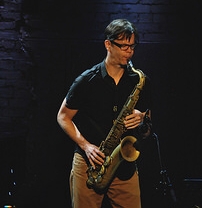 If
the earth is tilted towards the sun at a 23.5 degrees angle, Donny
McCaslin, no stranger to Montreal, dedicated himself to changing
the tilt, a challenge which inspired him to come up with a novel
interval or scale that conveyed the heights that had to be scaled
as well as the obstacles to overcome – and the tenacity
required to pull it off. Against minimalist compositions, he brings
an exceptionally unique and varied vocabulary. Unlike conventional
fusion, which bridges rock and jazz, his music provides an opportune
bridge for listeners looking to find their way from straight jazz
to free-form. However far out or abstract are his excursions,
there is a subdued but unmistakable lyricism in his playing, which
if you catch before it mutates serves as an excellent point of
entry to the kind of jazz you might normally refuse, which makes
McCaslin an important player in the ever expanding jazz universe.
If
the earth is tilted towards the sun at a 23.5 degrees angle, Donny
McCaslin, no stranger to Montreal, dedicated himself to changing
the tilt, a challenge which inspired him to come up with a novel
interval or scale that conveyed the heights that had to be scaled
as well as the obstacles to overcome – and the tenacity
required to pull it off. Against minimalist compositions, he brings
an exceptionally unique and varied vocabulary. Unlike conventional
fusion, which bridges rock and jazz, his music provides an opportune
bridge for listeners looking to find their way from straight jazz
to free-form. However far out or abstract are his excursions,
there is a subdued but unmistakable lyricism in his playing, which
if you catch before it mutates serves as an excellent point of
entry to the kind of jazz you might normally refuse, which makes
McCaslin an important player in the ever expanding jazz universe.
Among
the festival highlights was pianist Enrico Pieranunzi, who in
the tradition of Italian jazz and classical music (Scarlatti)
brought wonderful melody making to his always exciting and extended
improvisations, all of which were subsumed by impeccable technique.
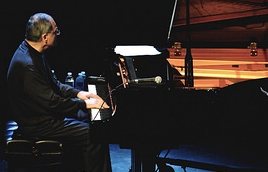
In the
New Talent Contest, where the winner receives a recording contract
with Montreal’s most prestigious jazz label, Effendi,
The Hugo Mayrand Trio took home the bacon. The pianist's (Jérôme
Beaulieu) and  guitarist's
superb musicianship
easily separated them from the competition, but the runner up
group, Night Clock, was a festival highlight: they brought extraordinary
creativity and invention to their set and offered a credible alternative
metric in respect to the criteria (technique and mastery of instrument)
used to pick competition winners.
guitarist's
superb musicianship
easily separated them from the competition, but the runner up
group, Night Clock, was a festival highlight: they brought extraordinary
creativity and invention to their set and offered a credible alternative
metric in respect to the criteria (technique and mastery of instrument)
used to pick competition winners.
There
were a couple of potentially unsettling developments in this year’s
15th edition. Since Jazz en Rafale is regarded as Montreal’s
purist jazz-only festival, Martin Levac’s homage to the
rock group Genesis was a bit off the wall, despite first-rate
musicianship from the pianist and bassist – no strangers
to the jazz idiom.
More
controversial was the highlight concert given by the festival’s
official spokesman, Michel Cusson, arguably one of the most significant
composers in the history of Quebec. In the late 70s and 80s, Cusson
headed Quebec’s, if not Canada’s, most famous fusion
band Uzeb, and he has written soundtracks for many movies, mostly
notably Séraphin, for which he was awarded the
Jutra (2003). He also penned the breathtaking music for Odysseo,
the world’s largest travelling tent-horse show. His gifts
as both a musician and composer are self-evident in his vast discography.
Inspired
by his travelling experiences, old photographs and documents,
for the festival’s closing concert Cusson performed -- against
video streaming in the background -- a selection of rock music
that he composed as if writing for film. 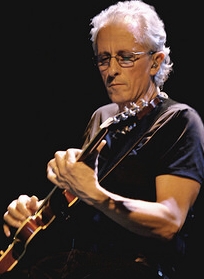 As
he describes it, he is exposed to an image or a sequence of images,
a gut reaction follows which he spontaneously translates into
music. Since he was giving a solo concert, to affect the full
sound he desired he had to resort to the controversial technique
of looping.
As
he describes it, he is exposed to an image or a sequence of images,
a gut reaction follows which he spontaneously translates into
music. Since he was giving a solo concert, to affect the full
sound he desired he had to resort to the controversial technique
of looping.
In electroacoustic
music, a loop is a repeating section of sound material, meaning
the musician can write himself a bass line, which he loops, and
then adds as many instruments and effects as required, over which
he performs live. During one of the heavy acid rock tracks, when
Cusson’s equipment manager brought in another guitar from
the wings, there was a necessary pause in his playing but the
looped music continued. For some, I’m sure, it was the equivalent
of a magician revealing his tricks.
From
the composer’s perspective, looping is an invaluable tool.
He can create an orchestra for himself without having to pay the
otherwise prohibitive musicians' salaries. Loops, easily created
and deleted, allow the composer to experiment with all sorts of
sounds, textures and melodies. A work that might ordinarily require
months to be brought to completion can be created in weeks. But
for live concerts, looping is no substitute for relating to live
musicians and the spontaneity we associate with especially improvised
music. Since looping is a strictly mechanical production, its
inclusion redefines the meaning of live performance, much like
lip-synching, now an accepted vocal mode, redefined video music.
Music lovers of course will argue they don’t care how the
music they love is delivered: good music is good music and that
should be the bottom line. Ultimately, audiences who buy the tickets
will determine if looping is to become an integral part of live
performance.
Aside
from the above mentioned questionable developments, Jazz en Rafale
must once again be congratulated for its imaginative and gutsy
programming. Montrealers and winter-resistant tourists were treated
to a range of jazz that reflected and regaled both diversity and
inclusivity.
Rumour
has it that next year’s festival will be dedicated to vocal
jazz – a March time of year I hope to be singing in the
rain.
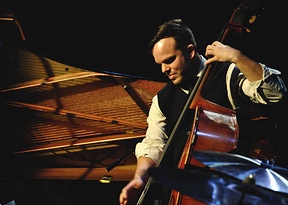
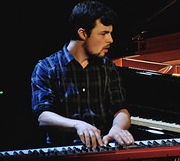
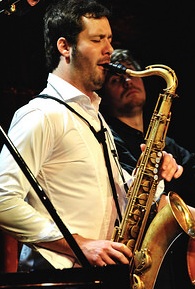
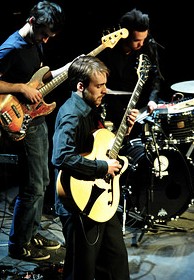
Photos
© Hanna
Donato